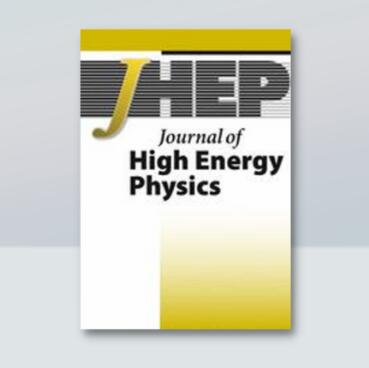作为暗物质候选者的稳定双频旋模
IF 5.5
1区 物理与天体物理
Q1 Physics and Astronomy
引用次数: 0
摘要
我们证明了具有标量自相互作用的旋量系统,如具有Yukawa耦合的Dirac-Klein-Gordon系统或Soler模型,一般具有双频孤立波解。我们开发了这种波的稳定性特性的方法,并使用径向缩减来表明(线性)稳定性确实适用于广泛的参数范围。我们证明了只有双频模式可以是动态稳定的,并建议稳定的双频模式可以作为暗物质的存储。该方法是基于(3+1)D Soler模型中单频孤立波的线性稳定性结果,这是我们作为副产物得到的。本文章由计算机程序翻译,如有差异,请以英文原文为准。
Stable bi-frequency spinor modes as Dark Matter candidates
We show that spinor systems with scalar self-interaction, such as the Dirac-Klein-Gordon system with Yukawa coupling or the Soler model, generically have bi-frequency solitary wave solutions. We develop the approach to stability properties of such waves and use the radial reduction to show that indeed the (linear) stability is available for a wide range of parameters. We show that only bi-frequency modes can be dynamically stable and suggest that stable bi-frequency modes can serve as storages of the Dark Matter. The approach is based on linear stability results of one-frequency solitary waves in (3+1)D Soler model, which we obtain as a by-product.
求助全文
通过发布文献求助,成功后即可免费获取论文全文。
去求助
来源期刊

Journal of High Energy Physics
物理-物理:粒子与场物理
CiteScore
10.30
自引率
46.30%
发文量
2107
审稿时长
1.5 months
期刊介绍:
The aim of the Journal of High Energy Physics (JHEP) is to ensure fast and efficient online publication tools to the scientific community, while keeping that community in charge of every aspect of the peer-review and publication process in order to ensure the highest quality standards in the journal.
Consequently, the Advisory and Editorial Boards, composed of distinguished, active scientists in the field, jointly establish with the Scientific Director the journal''s scientific policy and ensure the scientific quality of accepted articles.
JHEP presently encompasses the following areas of theoretical and experimental physics:
Collider Physics
Underground and Large Array Physics
Quantum Field Theory
Gauge Field Theories
Symmetries
String and Brane Theory
General Relativity and Gravitation
Supersymmetry
Mathematical Methods of Physics
Mostly Solvable Models
Astroparticles
Statistical Field Theories
Mostly Weak Interactions
Mostly Strong Interactions
Quantum Field Theory (phenomenology)
Strings and Branes
Phenomenological Aspects of Supersymmetry
Mostly Strong Interactions (phenomenology).
 求助内容:
求助内容: 应助结果提醒方式:
应助结果提醒方式:


